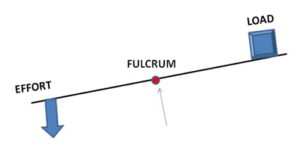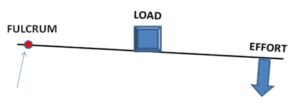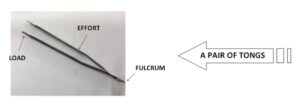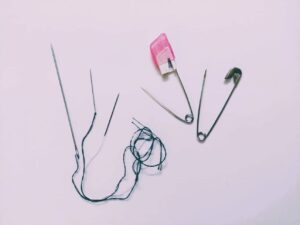Dear readers, I am here with another exciting n’ informative article about ‘Simple Machines’. In this post, we have revealed all those contents and common questions that click your mind while studying this topic, as mentioned below in the table of contents. Please read the article to get substantial knowledge about the topic. THANK YOU!
Q. What is WORK?
Work is said to be done when a force applied on an object displaces the object in the direction of the force. When we close or open a door, there is a change in the position of the door. Hence, work is done over here.
However, if the force applied is not able to move the object, then no work is considered. While reading, thinking or studying, there is no displacement or change in position of object. Hence, there is no work in the above activities.
Requirements of work to be done:
1) The force should be applied on the object.
2) The object should move a distance as a result of the force applied.
Q. What is ENERGY? 💪🥛🍹
To perform a certain work, you use the energy in your body. We know that, when you have more energy, you have more capacity to work. When you have less energy, your capacity to do work is reduced, and you get tired. So, the ability to do work is called energy. In order to perform any work, you need energy.
For example: We need less energy while watching television for two hours than jogging for half an hour. In the same way, doing household chores requires more energy than sitting at a desk and working on computer.
Q. Explain the different FORMS OF ENERGY? 💃🌞💻🔊
There are many forms of energy. Some of the basic ones are mentioned below –
Mechanical energy
The energy in an object due to its position or movement is mechanical energy. For example – usage of the moving water or wind to rotate turbines and produce electricity.
Light energy
This energy helps us to see the things around us. Plants use this energy to prepare their food. The Sun is the primary source of light on Earth. Candle, electric bulb, CFLs, etc. are some artificial sources of light.
Heat energy
This energy helps us to cook our food and keep us warm. We get heat energy from the Sun as well as burning fuels like coal, petroleum and kerosene. We use the heat of burning coal to rotate turbines and produce electricity.
Electrical energy
Most of our household appliances like mobiles, televisions, laptops, air conditioners work on electrical energy. In fact this form of energy is the most common and useful form of energy now a days. We get electrical energy from cells and generators. Electrical energy is supplied to our homes from powers stations.
Sound energy
Sound is a form of energy that is produced by the vibrations of objects. Some sources of sound energy are musical instruments, loudspeakers, radio, etc.
Q. What are MACHINES?
Definition of Machines 1
Tools and objects that help us to perform the same amount of work with much less effort than if we did the work manually are called machines.
Definition of Machines 2
Any device which makes work easier is a machine. Machines change the force or the direction of the force to make our work easier.
Sub-Q1. What are SIMPLE MACHINES and COMPLEX MACHINES?
Simple Machines
Tools that have few or no moving parts are simple machines. Simple machines require human energy in order to work. For example: spoon, knife, hammer, scissors, pliers, stapler, see-saw, and lemon-squeezer.
Complex Machines
Machines that have many moving parts are complex machines. For example: mobile phone, sewing machine, washing machine, car, weighing machine.
Sub-Q2. Describe the two ways in which machines utilize the force applied on them to make work easier.
1) Changing the magnitude of the applied force: It is very hard to open the lid of a tin can with our bare hands. However, a spoon multiplies the applied force (effort) and thus, it requires less effort to open the lid. Hence, a machine that multiplies the applied force is called force multiplier machine.
2) Changing the direction of the applied force: In some cases or circumstances, it is more advantageous and convenient for us to change the direction to apply the force. For example: pulling out underground water with the help of a hand pump (effort is applied downward and water has come upward.
Q. What are the TYPES OF SIMPLE MACHINES?
There are six types of simple machines –
- Lever
- Inclined plane
- Wedge
- Screw
- Pulley
- Wheel-and-axle
Read More Articles:
- File Management | Organization of Data
- Physical Quantities & Measurement | Physics | KnockLedge
- Inside Computers | Hardware and Operating Systems
LEVER
Q. What is LEVER?
Definition of Lever 1
A lever is a rod that can be turned about a fixed point.
Definition of Lever 2
A lever is a rigid bar that can rotate freely about a point.
A lever helps to move or lift an object with less effort. The greater the distance between the effort and fulcrum, the greater the load can be moved.
A lever consists of three parts:
- Fulcrum – the fixed point about which the lever can rotate is fulcrum (F)
- Load – the object to be lifted or moved with the help of the lever is load (L)
- Effort – the force applied on the lever is called the effort (E)
Q. What is the PRINCIPLE OF A LEVER?
The principle of a lever states that the product of the load and the load arm is always equal to the product of the effort and the effort arm.
Load × Load Arm = Effort × Effort Arm OR [katex] \frac {Load} {Effort} = \frac {Effort Arm} {Load Arm} [/katex]
It is the mechanical advantage of a lever (leverage).
For Example: On a see-saw, the child with lighter weight has to sit some distance away from the fulcrum so that he/she can lift the heavier child.
Try the ACTIVITY below to understand better about the principle of a lever.
ACTIVITY!!
Aim: To understand the principle of a lever practically (by making a small see-saw).
Materials required: a ruler, an eraser (heavy weight), a sharpener (fulcrum)
NOTE: Your index finger will act as the lighter weight applying the effort.
What to do?
- Take a sharpener and make it stand vertical on a plane surface.
- Place a ruler on it (keep in mind that both the sides should be equal)
- Then, put an eraser (heavy weight) on one of the sides.
- From the opposite side of the ruler, place your index finger and apply force far away from the fulcrum.
Observation: The eraser (heavier weight) has lifted up by the force applied by your finger when it was further away from the fulcrum. This distance between your finger and the fulcrum helped to lift the load with much less effort, than if you applied it when your finger was near to the fulcrum.
Conclusion: Load × Load Arm = Effort × Effort Arm.
Q. What are the three TYPES OF LEVER?
There are three classes of lever (you will notice a slight difference between them) based on the different positions of the effort, load and fulcrum. They are as follows:
Class 1 Lever or Levers of First-Order
Class 2 Lever or Levers of Second-Order
Class 3 Lever or Levers of Third-Order
Q. Describe CLASS 1 LEVERS.
Class 1 Lever or Levers of First-Order – The fulcrum lies between the load and the effort. They usually help us by multiplying the applied force. Hence, the other name of such levers is FORCE MULTIPLIERS. The effort arm (effort to fulcrum) can be longer, equal to or shorter than the load arm (load to fulcrum).
∴ The mechanical advantage can be more than 1, equal to 1 or less than 1.

For example: cutting pliers, scissors, beam balance, crowbar, see-saw.

Q. Describe CLASS 2 LEVERS.
Class 2 Lever or Levers of Second-Order – The load lies between the effort and the fulcrum. It usually helps us by multiplying the applied force. The effort arm (effort to fulcrum) is always longer than the load arm (load to fulcrum).
∴ The mechanical advantage is always greater than 1.

For example: nut-cracker, wheel barrow, bottle opener, lemon squeezer, paper cutter, oars (used to row a boat).
Q. Describe CLASS 3 LEVERS.
Class 3 Lever or Levers of Third-Order – We apply the effort between the load and the fulcrum. It usually helps us by reducing the applied force. The effort arm (effort to fulcrum) is always shorter than the load arm (load to fulcrum).
∴ The mechanical advantage is always less than 1.

For example: hockey stick, the human forearm, tongs and tweezers, forceps, fishing rod.

INCLINED PLANE
Q. What is INCLINED PLANE?
Definition of Inclined Plane 1
An inclined plane is a rigid (strong) sloping surface over which heavy loads can be raised or lowered to a certain height or depth.
Definition of Inclined Plane 2
Inclined means ‘sloping/slanted surface’. An inclined plane is a rigid (strong) slanted surface which is used to lift heavy loads up or down with much less effort (mechanical advantage is more and the effort is less) than using your bare hands. The force is multiplied when using an inclined plane.
An inclined plane is generally diagrammed as a wooden plank that is placed with one end on a raised surface and the other end on the floor forming an inclined (sloping) surface. It helps to lift heavy loads to a higher place with less effort.
For Example: When you have to lift a heavy box onto a truck, you can do it in two ways. First method is by your arms, and the second one is by using an inclined plane. Both the methods have the same results but the force (effort) multiplication is only possible when using an inclined plane. In the presence of an inclined plane (suppose RAMP), you have to put less effort in transferring the heavy box onto the truck (because you can easily push the load and the force is multiplied in this case), than using your hands for the same.
Mechanical Advantage is always greater than 1 (MA > 1) because:
Mechanical Advantage of Inclined Plane = [katex] \frac {Length of a plank} {Vertical height of the load raised} [/katex]
V.I.P. (must know): The amount of push depends on the weight of the load and the steepness (sharpness) of the slope. When the weight is more and the machine is steeper then, much more is required to lift the load.
WEDGE
Q. What is WEDGE?
A wedge is a double inclined plane that is formed when two slanting surfaces shrink to form a pointed sharp edge. It is generally used to slash, slice and cut things apart. For example: knife, axe and chisel.
Some wedges that are very sharp require more than two inclined planes. For example: needles, pins and nails. These tools are sharper than a simple knife.

SCREW
Q. What is SCREW?
A screw is a cylindrical rod just like a nail with grooves cut in it. In other words, it is an inclined plane wound around a rod. The zigzag spiral edge or the grooves in a screw are called threads. Because of these threads, the screw is not as smooth as a nail, it has a rough edge. Every turn of the groove or the thread helps to move and fit the screw easily anywhere.
Function: A screw helps to hold things together tightly.
The tip of a typical screw is narrow and sharp. The head has a narrow incision (cut) that is temporarily fixes in the screwdriver.
(Give Reason) As the screw is forced and rotated into a piece of wood, it travels a longer distance than a nail would do so.
A screw is advantageous than a nail because a screw is much easier to fix in a block of wood than a nail. The threads only present in a screw, grips the block of wood more tightly than a nail. The principle of a screw is also applied on a nut-and-bolt arrangement and a screw jack.
PULLEY
Q. What is PULLEY?
A pulley can be a wheel or a circular disc that can rotate freely about a point. The circular disc is of metal or wood that has a groove on its edge. A rope or a metal chain passes through the groove. The groove helps the rope or chain to stay in its position without slipping of the wheel.
The load is attached to one end of the rope or chain and the effort (force) is applied at the other end. A pulley majorly changes the direction of the applied force (from upwards against gravity and to downwards towards gravity.
Function: A pulley helps to lift heavy objects.
Q. What is SINGLE FIXED PULLEY?
- Has a fixed axis of rotation
- Attached to a rigid support
- We put the effort downwards to lift the load upwards
- Effort distance = Load distance
- Commonly used to draw water from a well
Q. What is SINGLE MOVABLE PULLEY?
- The axis of rotation is not fixed
- Part of the rope passing through the groove has a rigid support (strong wood branch)
- The load attaches to the pulley wheel
- We apply effort on the other end
- Commonly used by cranes to lift very heavy loads
WHEEL-AND-AXLE ARRANGEMENT
Q. What is WHEEL-AND-AXLE?
- The wheel-and-axle consists of a wheel attached to a rod known as the axle.
- When the wheel rotates, the axle also moves along with it.
- The main part which has to be particularly rotated is the axle.
- It is very difficult to rotate the axle barely without a support. That’s why we attach an easily-rotating wheel to the axle acting as an aid for rotation of axle
- The wheel and the axle are supporters to each others
- When you apply force on the wheel, the axle along with the wheel, moves with a greater force.
- g. screwdriver, door knob, pedals of a bicycle, steering wheel, drilling machine (carpenter), etc.
- It is not necessary that a wheel that is circular in shape should always be attached with the axle. It can be just a small handle too substituting the place of the wheel like in the case of a rotating spindle tap.
CARE OF MACHINES
- Machines should be provided with a clean environment consisting of almost no dust particles and moisture
- When not working on the machines, we should cover them with a cloth or something to prevent the dust particles entering on or inside them
- Iron-made machines should be covered with a layer coating of paint to prevent rust accumulated on it.
Machine moving parts should be oiled with good quality machine oil on a regular basis to reduce friction and wear and tear.
NUMERICAL PORTION
Q. Explain MECHANICAL ADVANTAGE of a machine.
The factor by which a machine multiplies the force applied is mechanical advantage.
Effort: the force applied on the machine to do some work is effort.
Load: the force applied by the machine on the abject is load.
Mechanical Advantage (MA) = load ratio effort = [katex] \frac {Load} {Effort} [/katex]
[NOTE: Greater the mechanical advantage of a machine, it requires lesser effort to do some work.]
Three Important Points
- If effort < load, then MA > 1
- If effort > load, then MA < 1
- If effort = load, then MA = 1
Machines that have mechanical advantage greater than 1 (require less effort), usually make work easier.
Some machines reduce the applied force. That means, their mechanical advantage is less (effort is more but load is less).
Q. What is EFFICIENCY OF A MACHINE?
The ratio of the work done by the machine (output energy) to the work done on the machine (input energy) is the efficiency of the machine.
Efficiency = [katex] \frac {Output Energy} {Input Energy} [/katex]
Efficiency is always in percentage (%). To take out efficiency in percentage, you need to follow the given formula:
Efficiency (in %) = [katex] \frac {Output Energy} {Input Energy} \times 100 [/katex]
Dear readers, we hope that this article is very useful and fruitful to you. If you further have any queries, you can drop in the comment section. You may write your valuable feedback for the article prepared. THANK YOU!!
To read NCERT Chapter Work With Machines and Materials, click here.

